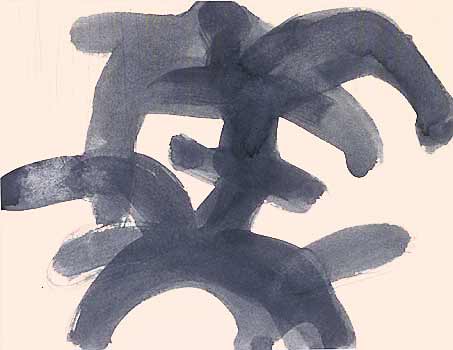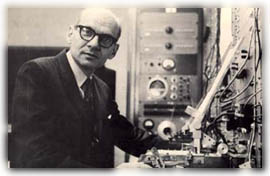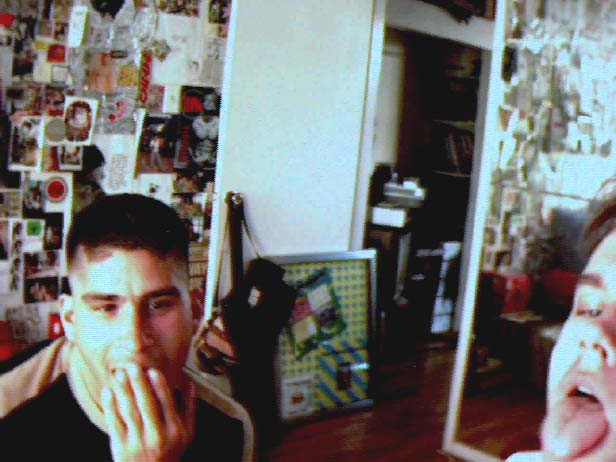
Matt Leines Ambassador of the Men with Lightning Fists (2004)
White Box is not a just an art gallery. It's become much more. It's something of a complete arts center, and it has a conscience. I'd say it's an alternative humanist space fed by and feeding all the arts.
Last night the courageous Chelsea non-profit space hosted a concert of contemporary art music for electronics, traditional stringed instruments and the customary Titano accordian. The ensemble was the new music group, ModernWorks, collaborating with the ubiquitous William Schimmel.
The environment was the very busy and very smart current installation, "Majority Whip," which remains open through this Saturday. We've already been back twice, and we'll be there again tonight and Saturday, when it closes. The work ranges from very good to phenomenal, and in spite of the general political context, there is surprisingly little hysteria, and most of it stands up aesthetically on its own very well.
Curators Kathy Grayson & Laura Tepper have invited young artists to assemble work and installations related to the human impact, or "lived reality" of government policy.
For the duration of Majority Whip, White Box will be transformed into a congressional interior, modeled after the chambers of the United States Senate. Podiums and circular benches, flags of unusual color, crests, funny blue carpeting, old fixtures and chandeliers and various symbols of power will be re-appropriated and slightly askew. The Senate floor will be used for lectures, performances and events during the run of the exhibition. All of the invited artists will have the opportunity to participate in this installation and have been encouraged to create site-specific work. The artists will donate partial proceeds from the sale of their work to America Coming Together and SAAVY, non-profits dedicated to voter registration issues and run by the League of Conservation Voters.
A partial list of the artists includes Chris Johanson, Jo Jackson, Erik Parker, Keegan McHargue, Rosson Crow, Andrew Guenther & Matt Leines, Dylan Walker, Simone Shubuck, Sarah Braman, Carl Bennett, Brendan Fowler, Daniel Joseph, Ashley Macomber, Assume Vivid Astro Focus, Shay Nowick, Scott Hug, Tracy Nakayama, Xylor Jane, Michael Magnan, Chris Lindig, Christopher Garrett, Scott Hewicker, Eamon Ore-Giron, Brian Belott, Dearraindrop, Randy Colosky, Jim Drain, Devendra Banhart, Shaun O'Dell, Hishaam Bharoocha, PFFR, Misaki Kawai, Ry Fyan, Taylor McKimens, Justin Samson, Michael Mahalchick, Koji Shimizu, Jules de Balincourt, Katie A. Davis, Sara Thustra and Jeremy Yoder.
The performance last night included only one overtly-political piece, Michael Daughtery's "Sing Sing: J Edgar Hoover," composed for string quartet and the original G-man's sampled voice, but the remainder of the program was no less provocative musically. My favorites were Gubaidulina's "silence" and Rihm's "Am Horizont," although the charms of Anthony Cornicello's "I'll Have An Electric Mahabharata, Please" for cello and live electronics were seductive. I'ts still a shame that the gestures of most computer instrumentalists are unable to rival those of even a buttoned-up traditional player. Madeleine Shapiro, the cellist and founder of the ensemble, was not buttoned-up.
Tonight, beginning at 6:00 or 6:30 there will be a political art show and cocktail party, tagged "Majority Whipped," in the gallery space, mixing artists and creative activists, "with signs, banners, soapbox speechifying, hats, flags, light-up clothing, flash projections, apple pie, music, invisible performance" according to the organizers' website.
On Saturday there will be a combined exhibition closing party and release party for the catalog edited by Scott Hug. It sounds like the celebration will really get going around 5 o'clock.
The trick would be to get the people who almost filled the seats last night to show up tonight and Saturday, just as it would have been quite a trick to get the artists and activists into the room last night, but if all that were to happen so easily, much of the need for a space like White Box would already have been filled, and we know it's not going to be so easy.
[image from White Box]





